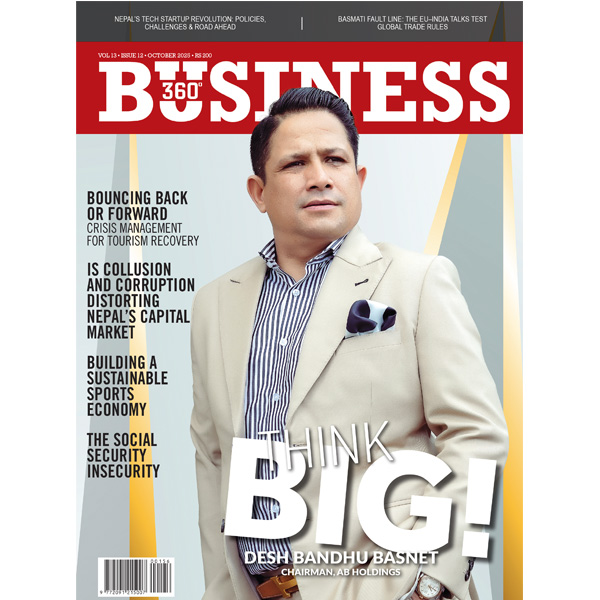
Since the late 70s, the burgeoning number of restaurants has had a strong presence on the city’s food map. With the growing dining culture, B360 spoke with some of the capital’s ace restaurateurs on their business, challenges and success mantra. Excerpts:
[nextpage title="Rum Doodle Bar & Restaurant" ]Rum Doodle Bar & Restaurant pays tribute to the spirit of mountaineering. Established in 1979, the name Rum Doodle origins from the novel The Ascent of Rum Doodle by W.E. Bowman. An iconic landmark in the food business, here’s what Owner Ashok Pokharel has to say:
 What is the story behind Rum Doodle?
What is the story behind Rum Doodle?
Rum Doodle started out as an adventurers’ hangout. How it came into existence is a story in itself. In the late 70’s, my family was in the adventure business which we still are in and we felt the acute requirement of a restaurant which would diligently cater to mountaineers with full portion meals. Hence, my father along with his friends came up with the idea of an adventure-themed restaurant and named it ‘Rum Doodle’. The yeti footprints also have a story. One day, Sir Edward Hillary was in town and he dropped by. He signed on a piece of plywood and we stuck it behind the bar. Since then the bandwagon followed.
In today’s context, is the restaurant business more about experience than the food?
In Nepal, there is a fixed number of people who would go out regularly to wine and dine. On the other hand, every time a new restaurant turns up, the crowd shifts. This way the footfall fluctuates on the basis of newer experiences being offered.
What are the challenges in terms of surviving in the market and growing business?
Price sensitivity of the clientele is the biggest challenge. This is also one of the reasons why we moved from Thamel to Naxal. Thamel was becoming too expensive as far as the rent was concerned. Even for a third floor, we were paying a hefty amount. Also, after the earthquake we were closed for a month and for the other seven months we were sitting idle. So, we wrapped up the operations in Thamel and moved to a smaller place here.
What has been a significant change in the food market over the years?
The ingredients available then and the ingredients available now are totally different. In the earlier days, when we used to talk about cheese, it used to be yak cheese and that was it. Now you can buy a basket full of cheese. Also, competition is much more cutthroat now. There’s a restaurant in every second house.
What has been your success mantra?
The adventure theme is our USP. And our success mantra lies in responding to the needs of the customers.
[/nextpage] [nextpage title="Fire and Ice Pizzeria" ]Opened in 1995, the pizzeria has become a dining staple in Kathmandu, especially for the small expatriate community and Nepali pizza enthusiasts. Managing Director Anna Maria Forgione has created a place that people love to go back to and don’t mind standing in a queue to get in.
 What is the story behind Fire and Ice?
What is the story behind Fire and Ice?
I had been living in Kathmandu for seven years. I loved living in Nepal due to the best mild weather in the world. I was happy and content. I missed my country, Italy and felt that the authenticity of the Italian food sold in the Nepali market could be improved. In 1993, I began to sell my special tomato sauce at a farmers’ market at the Summit Hotel in Patan. After a while, I had customers awaiting my arrival to buy the tomato sauce. It was during that time I began imagining creating and running a public place where travellers could meet, have healthy and homely cooked meals before going onto their climbs. And it happened!
In today’s context, is the restaurant business more about experience than the food?
Perhaps. Food can add or detract from the overall dining experience. However it also differs greatly by the mood of each customer. The atmosphere, energy, quality of the food served with competence, cocktail, etc certainly add to the entire experience.
What are the challenges in terms of surviving in the market and growing business?
Once you reach a ‘brand’ status, it is tough to stay at the same level. But there is no choice. Hard work and motivation for everyone working together as a team is the winning ticket. Another is being flexible with the menu to accommodate some dietary requirements. Today, there are many new diets which must be catered for as some guests require gluten free, dairy free, fat-free, organic, etc. Above all, knowledgeable waiters, friendly staff and a reliable Wi-Fi is a must.
Observing the food scene over the years, where deos Kathmandu stand?
Kathmandu is always up for trying new things. Being the main tourist hub, it has to keep up with the changing times as well as keeping true to the Nepali traditions and culture that makes it unique.
What has been your success mantra?
Love and passion for what you do is the essence of success. It’s not a secret. When I started my business, I never thought about money and how much I would earn. I armed myself with all the love I had in my heart and the fuel of passion that my heart wanted to create and I got on with it.
[/nextpage] [nextpage title="Kaiser Café" ]Located on the premises of the lush Garden of Dreams, Kaiser Café is synonymous with European food. The light and serene atmosphere surrounding the neo-classical garden along with the architecture lends the place a particular European feel. We spoke with Basu Dev Pandey, the F&B Manager.
 What is the story behind Kaiser Cafe?
What is the story behind Kaiser Cafe?
Set against a historical background, the Café inside the garden gives you a chance to travel in the past and soak in the feeling of dining away from the chaotic world. The property is managed by the Dwarika’s Hotel for more than a decade.
In today’s context, is the restaurant business more about experience than the food?
Definitely, the experience counts but the symmetry with the food should be maintained. Despite growing competition from other cafes and those selling the same cuisine in the market, people visit us for a slice of nostalgia.
What are the challenges in terms of surviving in the market and growing business?
The key issue that continues to be a challenge for the café is the immigration of skilled manpower that has led to increased staff turnover. It is unfortunate for Nepal as a nation to have so many skilled individuals leaving the country for better opportunities. Having said that, the Dwarika’s Group has been blessed with a dedicated team whose hard-work reflects in the success of the Kaiser Café.
Observing the food scene over the years, where does Kathmandu stand?
The Kaiser Café has always attracted more foreign clientele. What we have learned over the years is our clientele prefer peaceful ambience. In terms of Kathmandu accepting new things, the burgeoning restaurants introducing new cuisines and the increasing trend of dinning out reveals that Nepali market is indeed accepting new experiences.
What has been your success mantra?
Located amidst this historical garden and use of organic food from our own eco-organic farms as far as possible have been our USP and success mantra for years. We also improve ourselves with every feedback.
[/nextpage] [nextpage title="Embers Restaurant" ]Among the list of new establishments, the chic Embers Restaurant, is sure to catch the eye. Opened in 2013, Embers has one of the best spaces among restaurants in Kathmandu. Dipesh Kunwar is the Owner.
What is the story behind Embers Restaurant?
Embers Restaurant was established in 2013 with a motive to take restaurant business to the next level in Nepal. Back then, there were very limited options in the market and people had to go to five-star hotels in order to get quality service, good ambience and quality food of international standards. There was a huge gap between hotels and normal restaurants in terms of food and service. We wanted to fill that gap by creating a place where guests could dine in a 5-star ambiance with food prepared in the well-equipped kitchen by an experienced chef.
In today’s context, is the restaurant business more about experience than the food?
I believe, in order to have a good experience, all your five senses have to be satisfied. Right from entering a restaurant till the time you leave, if the guests see, hear, smell, feel and taste right, that’s when they have the best experience. However, I still think food should always be the priority.
What are the challenges in terms of surviving in the market and growing business?
The failure rate in this business is very high. These are due to different reasons such as inexperienced owner, poor management and account keeping, wrong location, below par food, etc. On top of that, staff retention is the most challenging part. Government regulations, poor infrastructure, inflation, inconsistent supplies are other challenges every restaurant is facing currently. If these issues are handled tactfully, there are high chances of your restaurant lasting long.
Observing the food scene over the years, where does Kathmandu stand?
These days, people travel very frequently and they are exposed to what is being offered in the international market. People are always anticipating new concepts and we can see many of them have been successful in creating a buzz in the market.
What has been your success mantra?
Treat your guest right and provide good food and service that are value for money. Differentiating our products from what is offered in the market has been our success mantra.
[/nextpage] [nextpage title="Kotetsu Restaurant" ]Japanese cuisine is gaining prominence as is evident from mushrooming Japanese restaurants in major parts of the city. Run by Tomita Kensei, a Japanese Chef, Kotetsu Restaurant is regarded as one of the most authentic Japanese restaurants which opened its door 13 years back. We spoke with Ramesh Balami, the F&B Manager.
What is the story behind Kotetsu Restaurant?
The 72-year-old Tomita Kensei loved Nepal and wanted to spend the rest of his life here. He soon realised that there weren’t any authentic Japanese restaurants in the city and ended up opening one. The huge pan for cooking Japanese cuisine is called ‘kotetsu’ and hence the name Kotetsu Restaurant came into existence. We started running this restaurant in Pani Pokhari 13 years back. I have been associated with the restaurant since then. When the country was hit by the massive earthquake, we faced huge destruction and this way we moved to Hotel Ambassador in 2016.
In today’s context, is the restaurant business more about experience than the food?
So far as our restaurant is concerned, food has proved to be more important than the rest. We do not believe in live music as offered by other restaurants; we only believe in a live kitchen. We also validate our authenticity through the presence of a Japanese chef. This has been the trend since our initial days. The chefs from Japan occasionally visit us and we are expecting one next year.
What are the challenges in terms of surviving in the market and growing business?
Earlier when we started this restaurant, there were around 4-5 Japanese restaurants in the city, but now the number has risen to 40. This statistic however has not lowered our footfall; rather every year we see a certain percent rise in the business.
Observing the food scene over the years, where does Kathmandu stand?
The first six months were really hard. We only had customers from the Japanese embassy and the earning was measly. After six months, it gradually picked up in the market and now we are usually full house.
What has been your success mantra?
Hand-picked raw fishes directly imported from Japan have been our USP. Our 90 % ingredients are from Japan. The focal point of the restaurant is the counter seating at the Teppanyaki grill.
[/nextpage]


-1761806697.jpg)
-1758006240.jpg)
-1752225714.jpg)